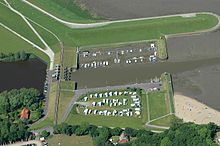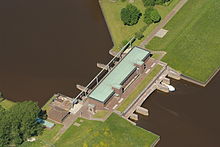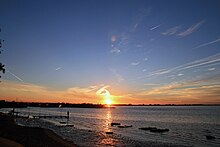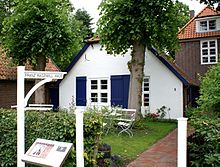Dangast
|
Dangast
City of Varel
Coordinates: 53 ° 26 ′ 48 ″ N , 8 ° 7 ′ 4 ″ E
|
||
|---|---|---|
| Height : | 8 m above sea level NHN | |
| Residents : | 545 (Jun 30, 2010) | |
| Postal code : | 26316 | |
| Area code : | 04451 | |
|
Location of Dangast in Lower Saxony |
||
The health resort of Nordseebad Dangast is located on the southwestern Jade Bay in the Friesland district and is part of the city of Varel . Dangast has 545 inhabitants.
history
Dangast's beginnings go back to the 11th century. During the second Marcellus flood in 1362, the first settlement of Dangast, which was a few hundred meters northwest of today's town, was destroyed and with it the ancestral seat of the Frisian chiefs of the Wimekinge, from which Edo Wiemken the Elder (chief of Rüstringen approx. 1354/1378 to 1415 ) emerged. After the Marcellus flood, Dangast was re-established in a flood-protected location on the southern slope of an Ice Age Geestrücken . Thanks to this location, Dangast is now one of the few places on the German North Sea coast where the construction of a protective dike is not necessary. The "dike-free sea view" made possible by this is one of the most important attractions of the place.
Around 1795, Count Gustav Friedrich Wilhelm Bentinck decided to create a seaside resort based on the English model. As early as 1797 it was reported that Dangast was often visited by bathers. In June 1825 Carl Friedrich Gauß , who was staying in Varel as part of the survey, took warm sea baths in Dangast.
The provisional facilities were replaced between 1804 and 1865 by the final, mostly preserved buildings. In 1874 the Wilhelmshaven-based contractor Linde took over the Dangast bathing establishment. He had the existing facilities renovated and built another lodging house for guests. In 1878 a windmill was built in Dangast as a so-called Erdholländer on the Wulfsgast and operated as a milling factory. In 1882 Carl Gramberg bought the lake bathing establishment with all its facilities. At that time, Dangast had three lodging houses with 100 beds. A further 30 beds were available as overnight accommodations in pensions. A storm surge from December 5th to 8th, 1895 caused extremely high water levels for over six tides . In Dangast, the bathing and beach facilities were damaged again. The Varel office counted 58 houses in Dangast at that time.
In 1904 Meyer's travel guide wrote for the first time about the North Sea resort of Dangast: "You take an apartment in one of the three lodging houses, which all belong to the same owner ...". After the demolition of the Varel lighthouse on the Kohlhof site at Varel harbor, the Arngast lighthouse was built in 1910 . It is located in the middle of the Jade Bay about five kilometers northeast of Dangast on a sandbank, which is on the same ridge as the former parish of Arngast . A resident of Dangast, known as "Aunt Klara", opened a restaurant and guesthouse called "Haus Tante Klara" on Kukshörner Weg in 1925. In 1935 Anton Tapken took over the Kurhaus with all the properties belonging to it and had it rebuilt in 1947 so that a completely new complex with a hall, kitchen, living rooms and staff rooms was created. During the Second World War, the Dangast heavy flak battery was set up in Dangast .
The storm surge from February 16 to 17, 1962 also hit Dangast heavily. The result was devastating damage to beach facilities and nearby buildings. The water flooded the entire Rennweide. In 1970, according to the wishes of some property planners, four high-rise buildings were to be built. The town center was intended as the central location. After massive protests by the villagers against the planned “village disgrace”, the project was abandoned. In 1974, construction began on the dike for the new seawater spring bath, which went into operation a year later. Dangast began to focus on the tourist destination . The North Sea health resort "Deichhörn" was built and the bathing facilities on the beach were expanded with sand flushing. In 1980 this spa center, to which a medical bathing facility is attached, was opened.
Dangast has long been a popular place to live and meet artists.
tourism
Dangast is the southernmost North Sea resort. It has an approximately two-kilometer-long sandy beach where you can swim during the tide (you can explore the mudflats at low tide ), several large campsites and a seawater swimming pool, the "DanGastQuellbad". The latter is prepared from a 573 meters below sea level, iodine - Brine fed source. This is about 40 million years old sea water. Adjacent to the spring bath is the “World Natural Heritage Portal” as the gateway to the Lower Saxony Wadden Sea National Park . The beaches in Dangast are accessible for free.
Dangast is known for its old Kurhaus and the Sielhafen . The Kurhaus was built in 1820 as the successor to the first "conversation house" from 1804 that had burned down. Boat tours through the Jade Bay with the Etta von Dangast are carried out from the Sielhafen .
In the summer months, the three-day Dangast Harbor Festival is a nationally known attraction, including a rare and spectacular championship in the sled race . Due to the lack of a current, the mudflat off Dangast consists of a lot of fine sediment and is therefore very muddy. On mudflat hikes, you often sink over your calves. A well-known hike, which should only be undertaken with an expert guide, leads to the Arngast lighthouse .
Arts and Culture

The expressionist painter Karl Schmidt-Rottluff ( Die Brücke ) stayed in Dangast between 1909 and 1912 during his work stays in the nearby restaurant “Haus Gramberg”, formerly “Parkschloss” . His colleague Erich Heckel stayed in the neighboring "Hullmann'schen Haus" (An der Rennweide 3) between 1908 and 1910. The “Haus Irmenfried” (An der Rennweide 42), formerly known as “Villa Wobick” with a striking wooden tower demolished in 1921, a favorite motif of Karl Schmidt-Rottluff, has been inhabited by the painter and photographer Willy Hinck (1915–2002) since 1950 .
An art museum was set up on Sielstrasse in the house of the painter Franz Radziwill , who lived there from 1923 until his death in 1983. He left behind an extensive life's work that ranges from expressionism to veristic still lifes to magical realism.
The painter Trude Rosner-Kasowski lived in Dangast from 1946 until her death in 1970.
In and around the Kurhaus, well-known and less well-known contemporary artists such as Beuys' students Anatol Herzfeld , Wilfried Gerdes and Eckart Grenzer have immortalized themselves with all kinds of artifacts.
Anatol Herzfeld was particularly active in Dangast in the 1970s, where he also created the polyester-built ship, “Tante Olga”, which with the help of Captain Anton Tapken, brother of the Kurhaus owner and operator Karl-August Tapken, from the Kurhaus Strand for Documenta 6, 1977, was brought to Kassel.
In 1984 the sculptor Eckart Grenzer ensured that the seaside resort of Dangast became the media center. Right on the beach, under the eyes of numerous spectators, he chiseled a 3.20 meter high phallus made of granite with the title “Encounter of the Sexes”. His artwork Friesendom , a sculpture in memory of the victims of past storm surges and a memorial for the constant threat to the coast from the sea, was inaugurated by the then Prime Minister of Lower Saxony, Christian Wulff , in 2005.
Since 2004, an art path has been remembering all these and other artists associated with Dangast.
Dangast is located on the so-called sculpture path art on the dike . The sculpture path was laid out in the Expo year 2000 and runs along the cycle path on the sea dike from Mariensiel to Dangast. The seven sculptures were created during a sculpture symposium and were created by seven different artists. The sculptures represent the seven days of the creation story . The sculpture next to the cycle path on the Dangast high bank represents the 7th day of creation. Eckart Grenzer called his work: "And God blessed the seventh day".
Every year, radio and television are there when the action art group “ Menschenmüll ” becomes active with their “Wattgolf”. The once well-known “Flugtag” spectacle, where imaginative hobbyists try to circumnavigate the Dangast harbor in their self-made aircraft to the delight of the spectators, has also taken place annually since 2006. At Christmas time, the group Menschenmüll organizes a satirical “Christmas theater” in the “Alten Kurhaus”, which is also known nationwide. With over 5,000 visitors, the "Watt en Schlick Fest", which has been taking place annually since 2014, is the most important music and culture festival in the region. The program of music, theater and literature takes place directly on the Kurhaus beach.
Nature and wildlife
Numerous species of Limikolen can be observed well from Dangast in the Jade Bay, which is part of the Lower Saxony Wadden Sea National Park and thus the Wadden Sea UNESCO World Heritage Site. During the breeding season , the redshank dominates in the Jade Bay as a typical Limikolen species. From September, during the migration period , it is especially large troops of avocets that moult here and look for food in the mud flats of the Jade Bay. Dunlins , Greenshanks , Dark Water Striders and Curlews complete the range of waders. Among the water birds, shelducks (actually shelducks) use the western jade bay near Dangast for moulting, breeding and resting and can be observed almost all year round in the mudflats near the beach. Pintails , teal and mallards can also be seen in large numbers during the migration times in autumn and spring.
In the area of the Binnendeichspütte, a small body of water near Dangast, geese and many other birds can often be found. Thousands of barnacle geese can sometimes be observed, especially when the birds migrate in autumn and spring . A small wooden pavilion that is accessible to everyone was specially set up for observation.
The National Park House Dangast provides information about these special features of the fauna in its exhibitions and public tours. The migratory bird days in the Lower Saxony Wadden Sea National Park deal with the issue of bird migration along the entire Lower Saxony Wadden Sea coast and also in Dangast every year in mid-October in numerous special events.
Occasional seals can be seen in Dangast Harbor. Visitors to Dangast can get close to the seals on a trip on the MS “Etta von Dangast”, which regularly offers excursions from the Dangast harbor to the seal banks in the Jade Bay.
Personalities
- Franz Radziwill (1895–1983), artist
- Willy Hinck (1915–2002), artist
- Karl-August Tapken (1936–2016), former owner of the old Kurhaus and holder of the Federal Cross of Merit
- Karl-Heinz Funke (* 1946), former state and federal agriculture minister and mayor of the city of Varel
- Heiko Daxl (1957–2012), artist
- Anatol Herzfeld (1931–2019), artist
Web links
Individual evidence
- ↑ a b City of Varel - figures, data, facts ( Memento of the original from April 21, 2009 in the Internet Archive ) Info: The archive link was inserted automatically and has not yet been checked. Please check the original and archive link according to the instructions and then remove this notice. , accessed May 5, 2014
- ^ G. Waldo Dunnington: Carl Friedrich Gauss: Titan of Science . The Mathematical Association of America, 2004, p. 133
- ↑ Dangast.de: Watt'n Blick: The new world natural heritage portal directly on the water and world natural heritage Wadden Sea . Retrieved July 14, 2015.
- ↑ Boat tours with the "Etta von Dangast"
- ↑ Norbert Ahlers: A special look in a strange landscape - pictures by the painter Rosner-Kasowski. In: Blog Vareler marginal notes. Norbert Ahlers, October 1, 2015, accessed January 9, 2020 .
- ↑ Christopher Hanraets: On the trail of important women. In: NWZ-Online. Nordwest-Zeitung Verlagsgesellschaft mbH & Co. KG, April 29, 2019, accessed on January 9, 2020 .
- ↑ The Kurhaus and Art From the "Brücke" painters, via Radziwill, Anatol to Grenzer. In: Website Kurhaus Dangast. Maren Tapken, accessed January 9, 2020 .
- ↑ Hans Begerow: Plastic by Anatol Herzfeld - How Aunt Olga came to Kassel. In: NWZ ONLINE. Nordwest-Zeitung Verlagsgesellschaft mbH & Co. KG, January 6, 2020, accessed on January 9, 2020 .
- ↑ Work of art "Encounter of the sexes"
- ↑ Eckhart Grenzer: 2004-2005 · The Friesendom in Dangast. Eckhart Grenzer website, accessed January 9, 2020 .
- ↑ Traute Börjes-Meinardus: Art Path - In the footsteps of Dangast artists. In: NZW ONLINE. Nordwest-Zeitung Verlagsgesellschaft mbH & Co. KG, July 14, 2016, accessed on January 9, 2020 .
- ^ Kunst am Deich , accessed on March 12, 2012
- ↑ Information on the regular event "Watt golfing"
- ↑ O. Ulbrich: Watt-En-Schlick-Fest - Dangaster Party should be the best festival. nwz-online from August 15, 2019; accessed on August 16, 2019
- ↑ The National Park "Lower Saxony Wadden Sea" . In: Wadden Sea National Park . March 17, 2010 ( nationalpark-wattenmeer.de [accessed October 17, 2018]).
- ↑ Felix Weiß, Christopher König, Christoph Moning, Christian Wagner: The Jade Bay in Lower Saxony, water bird paradise at the gates of Wilhelmshaven . In: Der Falke 57, 2010 . S. 132-135 .
- ↑ Lower Saxony Wadden Sea National Park: Dangast Inland Dyke Spuette. Retrieved October 8, 2018 .
- ↑ Events | National Park houses and centers of Lower Saxony Wadden Sea. Retrieved October 17, 2018 .
- ↑ 10th Migratory Bird Days in the Lower Saxony Wadden Sea National Park from October 13 to 21, 2018 | Migratory Bird Days. Retrieved October 17, 2018 .
- ↑ Outdoor show: Seals in the North Sea resort of Dangast - animal film - Germany's wild animals - Wadden Sea. February 21, 2016, accessed October 8, 2018 .
- ↑ Etta of Dangast. Retrieved October 8, 2018 .










